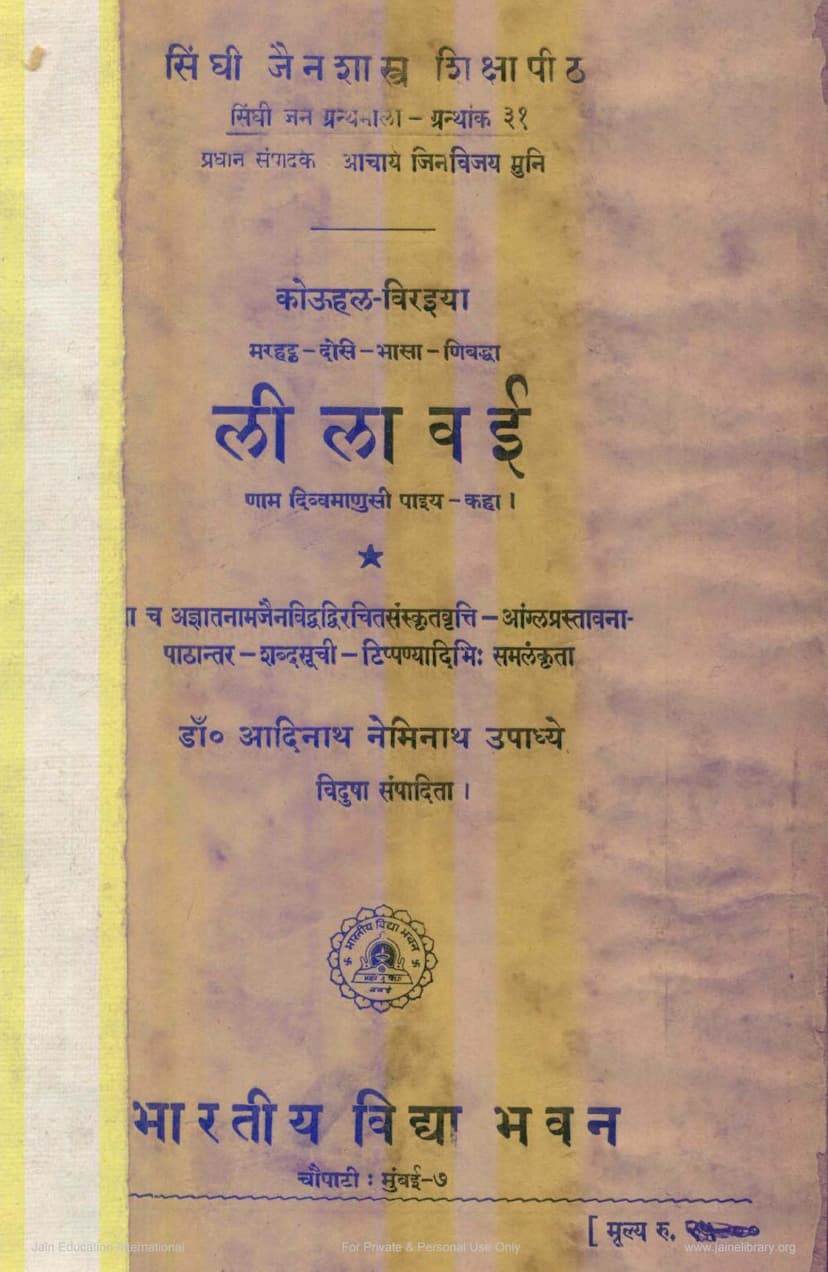Lilavai
Added to library: September 2, 2025

Summary
The Jain text "Lilāvati" by Kouhala, edited by Dr. A. N. Upadhye and published by Bharatiya Vidya Bhavan, is a romantic kāvya in Mahārāstrī Prākrit. It narrates a captivating story that intertwines the lives of several characters, showcasing themes of love, destiny, and the consequences of actions.
The story is set in ancient India during the reign of King Satavahana, also known as Hala. The narrative begins with several auspicious salutations and verses dedicated to deities, setting a devotional tone. The author also provides a brief autobiography, mentioning his grandfather Bahuladitya and father Bhusana Bhatta, and attributing his own name as Kouhala. He dedicates the poem to his beloved, Savitri, who inspires him to narrate this tale.
The plot of "Lilāvati" is complex and engaging, featuring several interwoven storylines:
-
The story of Kuvalayavali: The narrative begins with the penance of King Vipulasaya, interrupted by the celestial nymph Rambha. Their union results in the birth of Kuvalayavali, who later falls in love with the Gandharva prince Citrangada. Their union is cursed by her father, leading to separation and further trials. Kuvalayavali's story involves her mother Rambha and the Yaksha king Nalakubara, and her subsequent journey to find her lost husband.
-
The story of Mahanumati and Madhavanila: The Vidyadhara king Hamsa has two daughters, Vasantaśri and Saradaśri. Saradaśri is cursed by Ganesa and is later reborn as Mahanumati, who falls in love with the Siddha prince Madhavanila. Their love story is marked by separation and the quest to reunite, with Kuvalayavali playing a supportive role.
-
The central story of King Hala and Lilavati: King Satavahana (Hala), a renowned monarch, is destined to marry Lilavati, the princess of Simhala. Lilavati, depicted as a virtuous and charming princess, falls in love with Hala after seeing his portrait. Her journey to marry Hala is fraught with challenges, including her resolve to wait until her sister Mahanumati is happily reunited with her lover. The king's military expedition against Simhala, his encounter with King Silamegha, and the eventual marriage of Hala and Lilavati form the core of the narrative.
The text highlights several important themes and literary elements:
- Jain Literature: The publication is part of the Singhi Jain Series, indicating its significance within Jain literary tradition. The presence of a Sanskrit commentary by a Jain author further underscores this connection.
- Prakrit Language: The poem is written in Mahārashtri Prakrit, a significant literary language of ancient India. Dr. Upadhye's critical edition meticulously analyzes the dialectal features of this language.
- Romantic Narrative: The "Lilavati" is a romantic tale that emphasizes love, courtship, and the overcoming of obstacles to achieve union. The narrative often draws inspiration from classical Indian literature, with characters and motifs reminiscent of works like the Brhatkatha, Kadambari, and Ratnavali.
- Mythological and Religious Elements: The story incorporates elements from Hindu mythology, including the intervention of gods and curses, as well as Jain philosophical concepts, particularly in the context of the commentary and the overall series.
- Historical Context: The poem is dated around 800 AD, reflecting the political landscape of the Deccan during that period, with references to dynasties like the Rastrakutas and Chalukyas. King Hala himself is a prominent figure in Indian history and literature, known for his collection of Prakrit verses, the Saptashati.
- Editorial Significance: Dr. A. N. Upadhye's critical edition is notable for its comprehensive introduction, variant readings, glossary, and extensive notes, making the text accessible to scholars. The introduction provides a detailed analysis of the manuscripts, the author's life, the story's structure, its literary contacts, and the linguistic features of the Mahārāṣṭrī Prākrit used.
In essence, "Lilāvati" is presented as a significant work in Jain and Prakrit literature, offering a rich tapestry of romance, mythology, and linguistic artistry, critically edited for the benefit of scholarly research. The publication also serves as a memorial to Babu Bahadur Singhji Singhi, a prominent patron of learning, under whose inspiration the Singhi Jain Series was founded.